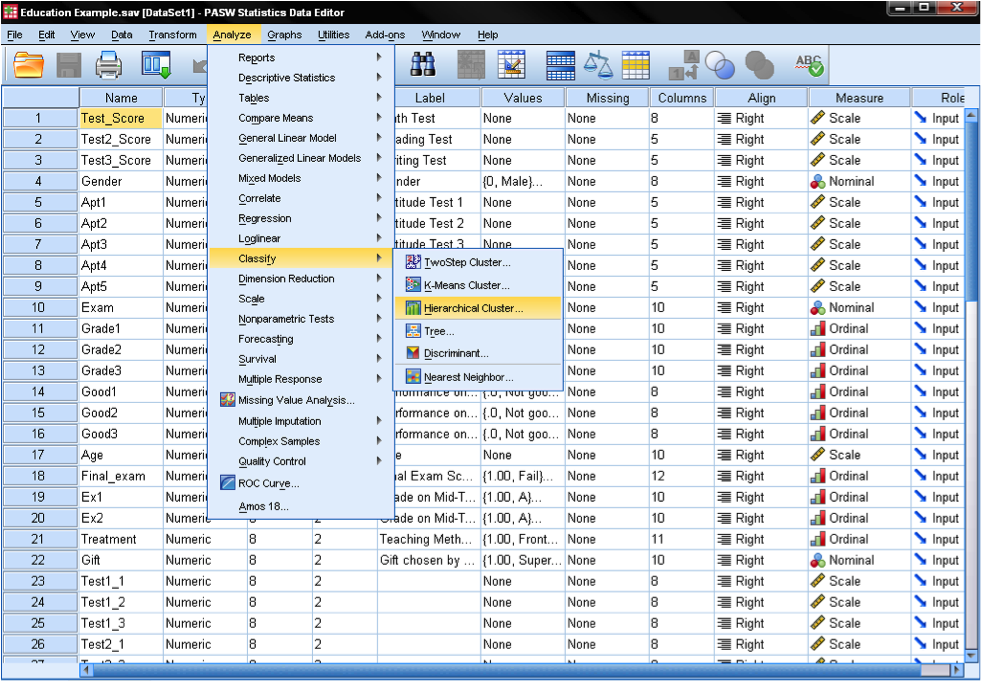How to Run Cluster Analysis in Spss
In this video Jarlath Quinn explains what cluster analysis is how it is applied in the real world and how easy it is create your own cluster analysis models. Remove any items with communalities less than 02 and re-run.

Conduct And Interpret A Cluster Analysis Statistics Solutions
An initial set of k seeds aggregation centres is provided First k elements Other seeds 3.

. From the menus choose. K-means cluster is a method to quickly cluster large data sets which typically take a while to compute with the preferred hierarchical cluster analysis. K-Means Cluster Hierarchical Cluster and Two-Step Cluster.
First model fit must be evaluated by the silhouette coefficient which is a. Hierarchical Cluster Analysis From the main menu consecutively click Analyze Classify Hierarchical Cluster. In the dialog window we add the math reading and writing tests to the list of variables.
Run this step-by-step example on a downloadable data file. This procedure pastes CLUSTER command syntax. Based on our initial research we decided to proceed with two-step cluster analysis as it allows for ordinal data to be clustered and the optimal number of clusters are found by the algorithm.
SPSS has three different procedures that can be used to cluster data. Given a certain treshold all units are assigned to the nearest cluster seed 4. Select the categorical nominal ordinal and continuous scale fields that you want to use to create segments.
Google Kirills spss macros page and. Optionally you can select an identification variable to label cases. They are all described in this chapter.
You can validate two step cluster solution following the methodology suggested by Norusis 2008. Select the variables to be analyzed one by one and send them to the Variables box. A K-Means Cluster Analysis allows the division of items into clusters based on spe.
Cluster analysis with SPSS. Cluster analysis with SPSS. Select the variables to be used in the cluster analysis.
Direct Marketing Option Related information. In this video I walk you through how to run and interpret a hierarchical cluster analysis in SPSS and how to infer relationships depicted in a dendrogram. Specify the number of clusters.
Hierarchical cluster analysis k-means cluster and two-step cluster. The number k of cluster is fixed 2. I decided to use the two step cluster analysis because the dataset contains categorial variables like gender and education.
The aim of cluster analysis is to categorize n objects in kk 1 groups called clusters by using p p0 variables. To Obtain a K-Means Cluster Analysis This feature requires the Statistics Base option. Now youll get 10 different solutions compare their quality and choose what you find best.
Basically the topic of my bachelor thesis is Lifestyles and sustainable consumption. Settings Cluster Analysis Parent topic. If you are clustering variables select at least three numeric variables.
K-Means Cluster Analysis Cluster analysis is a type of data classification carried out by separating the data into groups. SPSS FACTOR can add factor scores to your data but this is often a bad idea for 2 reasons. They are often used as predictors in regression analysis or drivers in cluster analysis.
The following dialog window appears. Analyze Classify K-Means Cluster. Quickly master factor analysis in SPSS.
In this video I show how to conduct a k-means cluster analysis in SPSS and then how to use a saved cluster membership number to do an ANOVA. Decide on the appropriate method and rotation probably varimax to start with and run the analysis. Optimize the number of factors the default number in SPSS is given by Kaisers.
The number of clusters must be at least 2 and must not be greater than the number of cases in the data file. If you have a large data file even 1000 cases is large for clustering or a mixture of continuous and categorical variables you should use the SPSS two-step procedure. This video demonstrates how to conduct a K-Means Cluster Analysis in SPSS.
Analyze Classify Hierarchical Cluster. In SPSS Cluster Analyses can be found in AnalyzeClassify. You can automate this with Python an example that comes close to this is Regression over Many Dependent Variables.
See the Data section above for information on measurement level Click Run to run the procedure. Go back to step 3 until no reclassification is necessary. Most important internal clustering criteria to compare clustering results and to choose the best number of clusters - are available in SPSS too.
First we have to select the variables upon which we base our clusters. The first step would be to create a cluster analysis which clusters the data set and the second step would be to investigate which of. The hierarchical cluster analysis follows three basic steps.
SPSS offers three methods for the cluster analysis. New seeds are computed 5. All steps are explained in very simple language.
Suggests removing one of a pair of items with bivariate correlation scores greater than 08. Select Segment my contacts into clusters. 1 calculate the distances 2 link the clusters and 3 choose a solution by selecting the right number of clusters.
You can run the same clustering syntax repeatedly say 10 times and randomly reorder cases between runs. From the menus choose. As with many other types of statistical cluster analysis has several variants each with its own clustering.
If you are clustering cases select at least one numeric variable. Choose Cluster Analysis Method.


Comments
Post a Comment